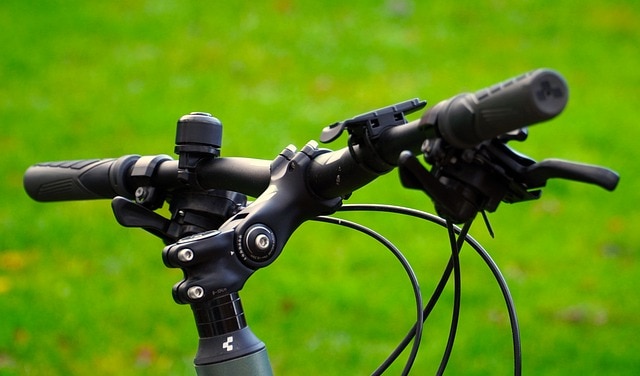

Achy neck? Back pain? General numbness?
These are all signs that your handlebars on your mountain bike could be too low. Knowing how to raise handlebars on mountain bikes could be your answer.
I know this as I suffered from bad back pain for several rides before I figured out what the problem was. A few millimeters can make the difference and it's a 10-minute job.
In this guide we'll be looking at:

Table of Contents
The height of the handlebars can often be overlooked when trying to find the optimal geometry for cycling and that can be quite the oversight!
It's common for riders to adjust the height of the saddle, handlebar angle, suspension settings, basically everything else! It's easy to overlook how much changing your handlebar height can impact how your bike handles.
[Beginner to bike fits? Take a look here]
They call it the 'cockpit' after all!
When you first purchase your bike, it's rare to find that the handlebars will be at the best height for you. This will affect your handling and your comfort on the bike.
Some bike shops will adjust the handlebars if need be but for those that don't, it's a simple job to do yourself. A few screws and you could have your bike's handlebars and stem at the optimum height for cycling.
The term 'bar height' is interchangeable with 'saddle drop. This is a measurement of where the saddle sits in relation to the handlebars.
You can increase traction on your front wheel fork when you place more weight on that - something some of you will already know I'm sure.
One important fact is the lower the height of the handlebars, the lower your center of gravity so it can provide a way to increase traction.
What you also get from reducing the handlebar height is a more centered position.
Why is that good?
Greater control! Especially when you're climbing.
From what I've just said you could now be thinking of lowering your mountain bike handlebars as low as you can take them. I wouldn't blame you. However, as with everything in life, it should be done in moderation.
Take it too far and there are negatives.
If you lower the level of your handlebars too much you will notice a negative effect on your bicycle performance. Making it challenging to control and not so easy to manage when it comes to cycling on tough climbs.
Fortunately adjusting the position of the handlebars is simple (and free!) so you can spend a bit of time getting it perfect for you - trust me, it'll pay off!
I'm going to talk you through a modern threadless style stem and headset process.
A good way to tell if it's a threadless headset is if on the steerer tube you can see bolts and screws that are pinching into it.
This is the easiest way to adjust the handlebars. Adding a spacer will instantly raise the position and height of the handlebar.
If you're not sure where headset spacers are, they are on the fork's steerer tube.
These days it's common for bikes to have 20 to 30mm of headset spacers. If you need to adjust anything, these can be placed either on top of the stem or below it to get the correct handlebar height.
The bolt in the handlebar stem will be standard-threaded so easy to work with.
It's good to have the wheels of the bike firmly on the ground. From there you can loosen the screws on the stem.
They can be found at the back of the stem. Loosen each one. I prefer to loosen each one gradually, working my way between them until I reach the point where I'm not feeling any fight.
I'd also advocate adding a bit of grease to the top cap bolt. In my experience, this can seize up over time so it just makes your life easier!
Now you can remove the stem cap bolt and stem cap.
You should now be able to slide the stem off easily, without too much pressure.
Now it's time to make those adjustments for your handlebar! Add in how many spacers you think you need to raise the handlebars to the position you want.
You should find that there are different sized spacers, giving you the ability to play around with the height until you get the handlebars where you want them.
Tip - Changing the level of your handlebars can have a big impact on your riding position. It may take a few goes to get things perfect.
When you're happy with where things are, slide the stem back onto the tube.
If there are any spacers you have leftover, they should go above when you just placed the stem.
You will need to make sure that there is a gap of around 3-5mm between the steerer tube and the top of your stem. This will make sure there is sufficient space for the headset system.
If you find that there isn't a gap, it could be a sign that you're missing a few spacing rings.
Take the top bolt and tighten it in place. Again, do this until you sense resistance on the stem.
It's important that you don't tighten the top bolt and screws too tightly as this can prevent the handlebar from turning easily.
In the same vein, if you don't tighten the screws enough then you're going to get a vibration through the stem and bike frame and it will generally feel unstable.
You may have noticed that the stem doesn't quite line up with the front wheel. This is the point at which we fix this.
The best way to do this is to have the top tube length between your legs, giving you the view you would get if you were riding your bike.
It's worth spending some time over this step, speaking as someone who has lined up the bars slightly off from the front wheel - it does make a huge difference when you're cycling.
When you're totally satisfied that the front wheel is lined up with the stem, you need to torque the side bolts. I'd recommend a torque wrench for this.
The handlebars should be put back together now. Check your handy work!
A good way to do this is to take hold of the brake. Take the headset with one hand and wobble the handlebars back and forth - gently.
You're looking for the feeling that the steerer is moving back and forth.
If you can feel this then some adjustments will need to be made. Just as you did before, loosen the side clamps and try to tighten up the stem cap bolt - not much though, be careful about overtightening! Then tighten the side clamps again.
Repeat the step until you can't feel any movement. It's important that the handlebars still move smoothly too. It's a fine balance, as I'm sure you'll discover!
A threaded handlebar stem can be identified by the fact they have one continuous piece of metal - connecting the handlebars to the bike frame. With this set-up, there is a single stem cap bolt, which can be found on the stem.
20% of mountain bikes today have a threaded headset so there's a 1 in 5 chance yours does!
Use an Allen key to loosen the bolt. From there you will need to loosen the locknut - this is likely to require a wrench. Some handlebars will have a hex nut.
Loosening the top bolt and nut (or hex nut) should allow you to be able to remove the stem from the mountain bike.
It's important to give thought as to what type of bike you're riding and what style of riding you like to do.
As we're focusing on MTBs, the most common set-up is that the mountain bike handlebars will be slightly lower than the saddle.
You don't want it so low that it impacts your comfort and control. This is why it can take a few attempts to set up the handlebars correctly.
Find the correct point for you and reattach the stem. Not forgetting to attach the stem bolt cap too!
When you raise the handlebars and/or stem it can bring about a number of benefits to your cycling. Some of this could be personal preference or simply the need to alter the bars as a child grows.
Here are a few of the most popular reasons riders raise their handlebars on their bikes:
It's common to hear about (and experience) back and neck pain, numbness, and general discomfort. Though it may not seem obvious, it can all be related to having the handlebars too low.
Bars that are much lower than the saddle will mean that you need to lean forward to get to the handlebars.
Yes, this has aerodynamic benefits but if we're talking about trail riders, aerodynamics aren't always at the top of the pile in terms of importance. It's more important not to put stress onto the width of your back muscles. Long days cycling in the saddle can lead to quite severe pain.
You should aim to pivot your hip and keep a neutral spine. This is difficult when the handlebars are too low and you're reaching for the stem and bars.
It can end up affecting your neck too. Being able to ride in a relaxed position is key to enjoying your cycling adventures!
If your handlebars are too low, it could mean that you are hunching over to ride - it already doesn't sound ideal, does it?
It can affect how much you can actually see. Slowing you down and making you a less efficient rider too.
Mountain bikes by design feature a handlebar fitted slightly lower than the seat.
If you've managed to get your kids into cycling then the trick is to find a bike that will fit them for as long as possible.
Adjusting the handlebars on their mountain bike can have the desired effect! Raising both handlebars and saddle can mean the bike will sit be a great fit for your child as they grow.
You will probably find that the handlebars need to be raised once a year, depending on how much your child grows, of course!
It can be surprising how much handlebars can affect bicycle performance when you're cycling. It can also be surprising how easy it is to remove the handlebars and raise the level to get the desired height.
You are unlikely to feel the true benefit until you go out for a ride. But hey, at least you know how to adjust the handlebars now, right? 🙂
Fancy a new bike?
